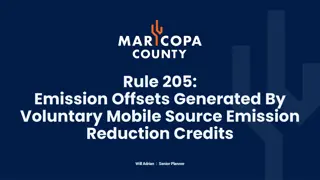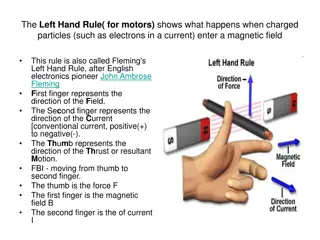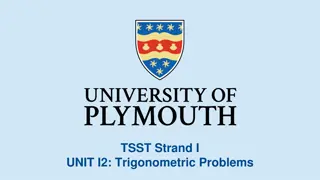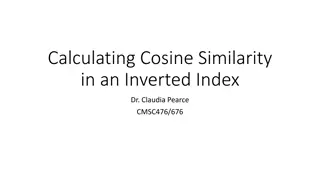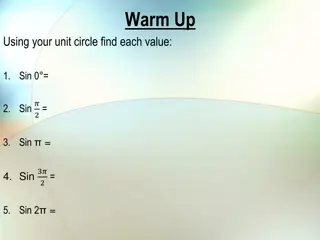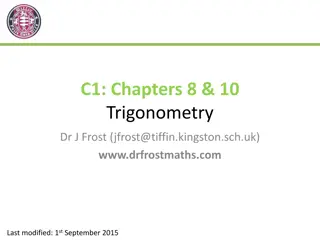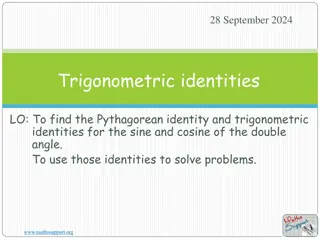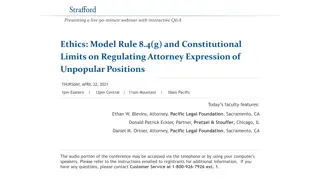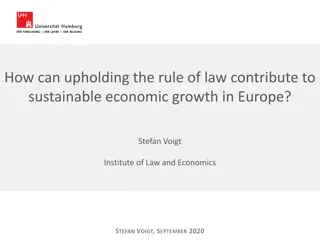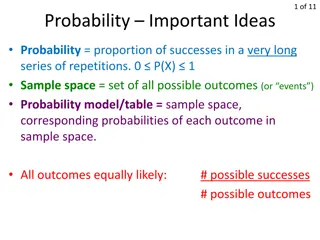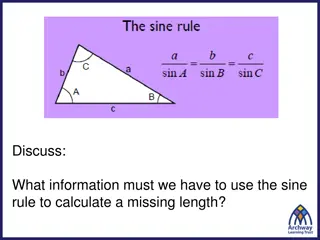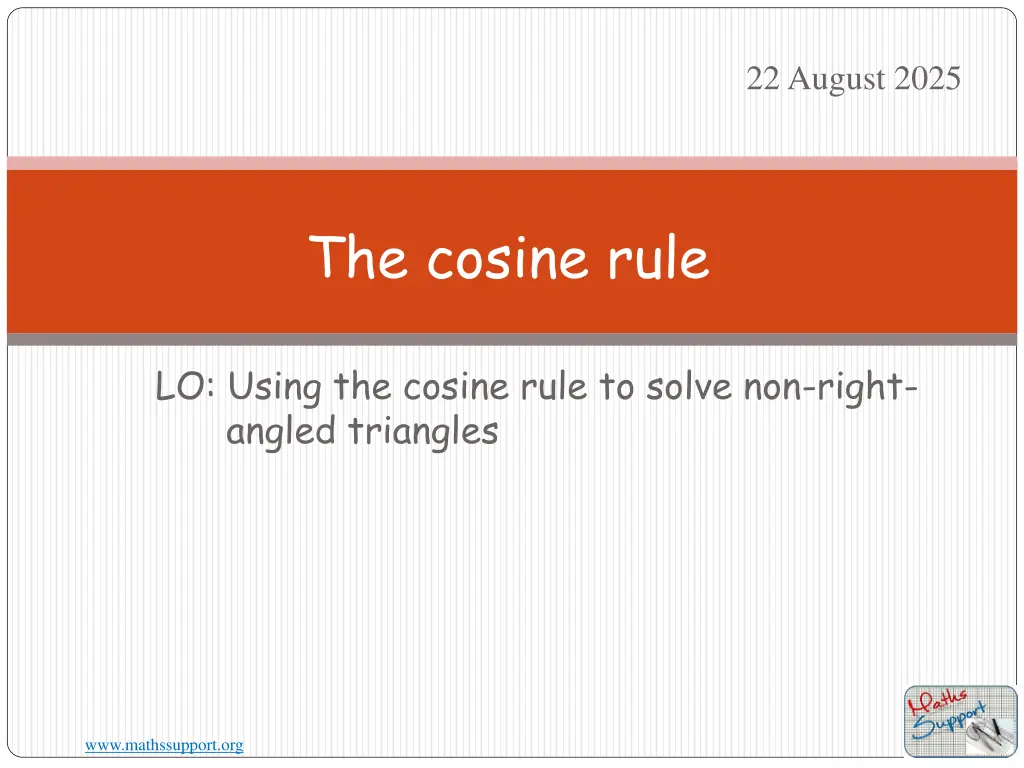
Understanding the Cosine Rule in Trigonometry
Learn how to use the cosine rule to solve non-right-angled triangles, calculate side lengths, and find angles in trigonometry. Explore practical examples and applications of the cosine rule in mathematics.
Download Presentation

Please find below an Image/Link to download the presentation.
The content on the website is provided AS IS for your information and personal use only. It may not be sold, licensed, or shared on other websites without obtaining consent from the author. If you encounter any issues during the download, it is possible that the publisher has removed the file from their server.
You are allowed to download the files provided on this website for personal or commercial use, subject to the condition that they are used lawfully. All files are the property of their respective owners.
The content on the website is provided AS IS for your information and personal use only. It may not be sold, licensed, or shared on other websites without obtaining consent from the author.
E N D
Presentation Transcript
22 August 2025 The cosine rule LO: Using the cosine rule to solve non-right- angled triangles www.mathssupport.org www.mathssupport.org
The cosine rule You can use trigonometry to solve triangles that are not right-angled. Look at the triangle ABC. is perpendicular to BC. In the right-angled triangle ACD, Pythagoras theorem gives b2= h2+ (a x)2 This gives In the right-angled triangle ABD. c2= h2+ x2 So h2= c2 x2 c2 x2 substitute the second equation for h2 The altitude (height), A h of the triangle, AD b c h b2= h2+ a2 2ax + x2 b2= h2+ a2 2ax + x2 C B x a x D a In triangle ABD cos? =? ? Substituting x x = c cos B So Take the first equation, b2= c2+ a2 2ac cos B + a2 2ax + x2 h2 b2= b2= c2+ a2 2ax This equation is one form of the cosine rule www.mathssupport.org www.mathssupport.org
The cosine rule The cosine rule is another method to calculate sides and angles of any triangle. It is used either to find the third side when two sides and the included angle are given or to find the angle when all the three sides are given To work out the sides For any triangle ABC with sides a, b and c opposite to angles A, B and C respectively: a2 = b2 + c2 2bc cos A A b2 = a2 + c2 2ac cos B c b c2 = a2 + b2 2ab cos C B C a www.mathssupport.org www.mathssupport.org
The cosine rule The cosine rule is another method to calculate sides and angles of any triangle. It is used either to find the third side when two sides and the included angle are given or to find the angle when all the three sides are given To work out the angles For any triangle ABC with sides a, b and c opposite to angles A, B and C respectively: b2 + c2 a2 2bc cos A = A a2 + c2 b2 2ac cos B = c b a2 + b2 c2 2ab cos C = B C a www.mathssupport.org www.mathssupport.org
Using the cosine rule to find side lengths If we are given the length of two sides in a triangle and the size of the angle between them, but we don t know if it is a right angled triangle, What to do?. For example: Find the length of side a We can use the cosine rule to find the length of the other side. a2 = b2 + c2 2bc cos A B c a 4 cm a2 = 72 + 42 (2 7 4 cos 48 ) 48 A C a2 = 27.53 (to 2 d.p.) b 7 cm a = 5.25 cm (to 3 s.f.) www.mathssupport.org www.mathssupport.org
Using the cosine rule to find side lengths If we are given the length of two sides in a triangle and the size of the angle between them, but we don t know if it is a right angled triangle, What to do?. For example: Find, correct to 3 significant figures, the length of AB We can use the cosine rule to find the length of the side c. B c2 = a2 + b2 2ab cos C a c 10 m c2 = 102+ 122 (2 10 12 cos 38 ) 38 C A c = 100 + 144 240cos38 b 12 m c 7.41 (to 3 sf) AB is approximately 7.41 m long. www.mathssupport.org www.mathssupport.org
Using the cosine rule to find angles If we are given the lengths of all three sides in a triangle, we can use the cosine rule to find the size of any one of the angles in the triangle. For example: Find the size of the angle at A B b2 + c2 a2 2bc cos A = 8 cm 42 + 62 82 2 4 6 cos A = 6 cm This is negative so A must be obtuse. cos A = 0.25 A = cos 1 0.25 A = 104 (to 3 s.f.) C A 4 cm www.mathssupport.org www.mathssupport.org
Using the cosine rule to find angles If we are given the lengths of all three sides in a triangle, we can use the cosine rule to find the size of any one of the angles in the triangle. For example: Find the measure of angle ? ?? a2 + b2 c2 2ab cosC = A cosC =122 + 142 112 2 12 14 cosC = 219 336 C = cos 1 b 11 cm c 14 cm 219 336 B C 12 cm a C 49.3 (to 3 s.f.) www.mathssupport.org www.mathssupport.org
Using the cosine rule to solve problems Ahmed can see two flag poles from where he is standing. One is 20 metres away from him and the other is 30 metres away. In looking from one flag pole to the other, Ahmed has to rotate through 35 . How far apart are the flag poles? First it is essential to draw a diagram from the given information. B a2 = b2 + c2 2bc cos A c a 20 m a2 = 302 + 202 (2 30 20 cos 35 ) 35 A C a2 = 317.02 b 30 m a = 17.80 m (to 2 d.p.) www.mathssupport.org www.mathssupport.org
Using the cosine rule to solve problems A ship sails 58 km on the bearing 072 . Once it has passed a reef, it turns and sail 41 km on the bearing 158 .How far is the ship from its starting point? We suppose the ship starts at S, sails to A on the bearing 072 Then change direction and sails 41 km to F on the bearing 158 To find the angle ? ?? 180 - 72 = 108 co-interior angles To find the angle ? ?? 360 - 158 - 108 = 94 angles at a point N x2 = f 2 + s2 2fscosA 108 158 A x2 = 582 + 412 (2 58 41 cos 94 ) N 58 km f 72 s x = 582+ 412 4756cos94 94 41 km S x 73.3 km (to 3 sf) x km F www.mathssupport.org www.mathssupport.org
Using the cosine rule to solve problems Two ships leave a dock at the same time. Ship A sails due north for 30 km before dropping anchor. Ship B sails on a bearing of 050 for 65 km before dropping anchor. Find the distance between the ships when they are stationary, to the nearest kilometre You need to find the length AB, the distance between the ships when they are stationary Using cosine rule Sketch a diagram B x km A b 65 a x2 = a 2 + b2 2abcosD 50 30 x2 = 302 + 652 (2 30 65 cos 50 ) x = 302+ 652 3900cos50 x 51 km (to the nearest km) D www.mathssupport.org www.mathssupport.org
Thank you for using resources from A close up of a cage Description automatically generated For more resources visit our website https://www.mathssupport.org If you have a special request, drop us an email info@mathssupport.org Get 20% off in your next purchase from our website, just use this code when checkout: MSUPPORT_20 www.mathssupport.org www.mathssupport.org




